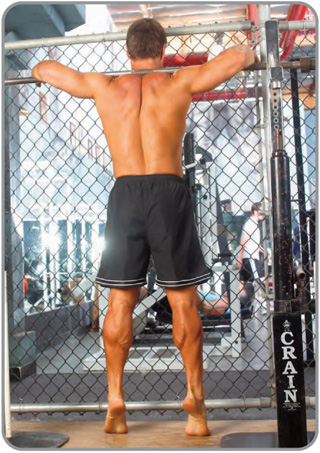
Question: Can you build good legs with plyometrics?
No. True ‘touch-and-go’ plyos are meant to rewire your nervous system, specifically teach you to recruit your muscles more, with more power, and make a better use of stored elastic energy.
Less intense and more voluminous jump exercises will work though, provided you have healthy knees and your legs are already reasonably strong. Dr. Michael Colgan, the author of The New Power Program (applepublishing.com), points out that mountain runners develop huge lower legs by “whacking their calves with big eccentric downhill braking stresses”. He recommends a radical regimen of downhill sprints to a bodybuilder lacking in the calf department.
For your quads try the jump squat variation popular with Russian kettlebell lifters. Clasp your hands behind your neck, keep your chest open, and quickly squat an inch or two below parallel. Immediately jump straight up; make sure to extend your body completely when airborne. Land on the balls of your feet, roll back on your heels as you are squatting down, and repeat. Maximum explosion is not necessary; the name of this game is sustained effort. This is NOT true plyometrics, after all. 2x10 is a good start. This exercise will spur new growth in your quads within days!
If you are interested in the complex science of plyometrics and want to know why the above exercises are not true plyos, read Supertraining by Mel Siff, Ph.D. available from elitefts.com.
Question: I train at home and can’t afford a Smith machine or a standing heel raise unit. All I have is a barbell and a squat rack. What can I do for my calves?
Here is an exercise from Anatomy of Strength, Dr. Arkady Vorobyev’s classic text on bodybuilding. It may not be for everyone but if you have healthy shoulders and decent coordination you will make great gains with it.
Hoist a barbell on your shoulders as you would for squats. Staying inside your power rack with the pins set high for safety walk forward towards the wall – I presume that your cage is parked next to a wall – and make sure the barbell is comfortably sitting in the groove on your traps. Carefully let go of the bar with one hand while balancing it with the other. Work your arm over the bar and press your palm against the wall at your head level. Exercising caution, untangle your other arm and rest its hand on the wall as well. Step on a three to four inch solid block – and you are in the standing barbell calf raise business.

Russian barbell calf raises.
Question: My calves just don’t grow no matter what I do. HELP!
Some Russian kettlebell lifting coaches recommend the farmer walk on the balls of your feet. Grab two bells, kettle or dumb, and go for it. Just walk around on your toes. For better results and greater ankle safety do the drill barefoot. It is even more special when practiced outside on uneven terrain.
Do not let your shoulders shrug up. Flex your tris and lats and push your shoulders away from your ears in the beginning. Then relax your upper body somewhat – but not your waist – while maintaining the described alignment. This will set your body in the most efficient position for the farmer walk.
Terminate each set before you drop the weights on your feet. It goes without saying that you will get a great grip workout in the process. Build up to five sets of two minutes each. Stretch your calves between the sets and afterwards. For obvious reasons this exercise belongs in the end of your session as a ‘finisher’.
Question: Can I build respectable legs without squats?
It depends on what you mean by ‘respectable’. If you want to give Tom Platz a run for his money, the answer is a resounding ‘no’. Nothing will maximize leg size as much as the basic squat. Nothing.
If you want your legs to be muscular and strong but you have no desire to go through a pair of dress pants in a couple of months, you can do it without squats. A stipulation: ‘without squats’ does NOT mean leg presses, leg extensions, leg curls, Smith machine squats, and other weenie moves! Following is a list of legit, hardcore, squat alternatives:
• The one legged squat or ‘pistol’ with a weight held in front or just the bodyweight;
• The front squat with a barbell or two kettlebells;
• The belt squat;
• The deadlift (a variety of stances are possible);
• The one legged deadlift with a barbell, two dumbbells or kettlebells;
• The saddle deadlift (also known as the Jefferson squat);
• The behind the back deadlift
• The Hack squat with a kettlebell.
The belt squat.
The kettlebell front squat. No wrist stress, Comrade!
The deadlift is not just a back exercise.
The sumo deadlift works the legs and hips even more then the conventional pull.
Americans call it ‘the Jefferson squat’.
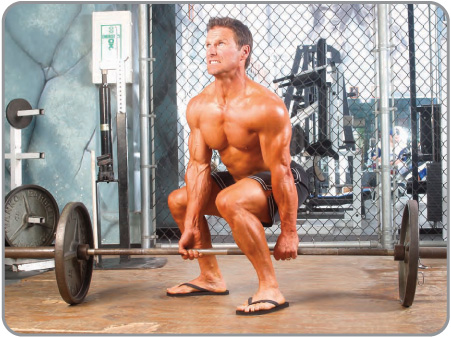
Russians call it ‘the saddle deadlift’.
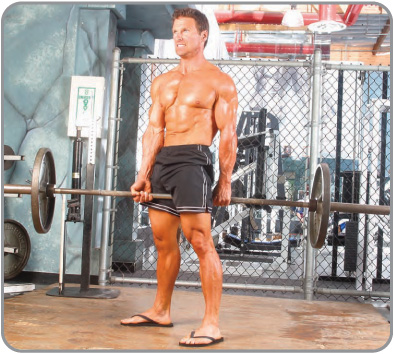
Whatever you call it, it is a powerful and somewhat dangerous exercise.
The behind the back deadlift: the numero uno leg drill for skinny dudes who want to deadlift big league weights.
Builds powerful legs that don’t chafe.
The Hack squat is a favorite of Brazilian Jiu-Jitsu world champion Steve Maxwell, RKC Sr. Go to Steve’s Philadelphia gym Maxercise and become a better man or woman.
Photo courtesy Maxercise.com
There are some other good exercises that follow the same pattern: multi-joint and free weight. And if you are even contemplating a mullet routine (leg press + leg extension + leg curl) – slap yourself silly!
Question: Are full squats bad for the knees and back? And what is a ‘full’ squat anyway?
A ‘full squat’ means your hams are resting on your calves. Olympic weightlifters squat that way. A ‘parallel squat’ is deeper than you think. The powerlifting rules insist that unless the top of your knee is higher that the crease separating your thigh and your lower abs, it is not ‘parallel’.
Regarding injuries to your knees and back, any depth squat could do when you do not know what you are doing. Full, parallel, and partial (anything above parallel) squats can be very safe and productive provided you have been taught the proper technique. The full squat is by far most technique demanding. Which is why it got the worst reputation, thanks to trainers’ incompetence.
There are two issues. First is the back and hamstring flexibility required to keep a proper lumbar curve. Most bodybuilders are way too tight, their tails tuck in, and their backs get injured.
Second, once they get to the point a couple of inches above parallel, most bodybuilders do not know how to go down deeper safely. The answer is ‘by pulling down with your hip flexors’. The muscle action is similar to the situp. If you are not sure what it means, watch my video More Russian Kettlebell Challenges.
The bottom line. For best development you should do all three types of squats. To squat safely you need to get flexible and technical.
Question: I love the front squat. I feel that it hits my quads like nothing else. Unfortunately my wrists and shoulders give out after just a few reps and I just can’t work my thighs hard enough. What is the answer?
The barbell front squat is a weightlifting exercise. It was never meant to be done for high reps. Three repetitions are about right. To make sure that you stimulate your fibers deep enough, just do more sets, for instance five to eight sets of three or ten to twelve sets of two. If you like higher reps use two kettlebells instead of a barbell. KBs can stay in the rack a lot longer than a barbell, with minimal or zero wrist and shoulder stress (not to be confused with discomfort).
When you front squat with a barbell always keep your elbows high. Mark Cannella, the head coach of the Columbus Weightlifting Club, recommends that you ‘cork’ or ‘wedge’ yourself under the bar as you are gripping it. The bar is a lot more likely to stay in place.
A note on the front squat depth: always go rock bottom. For reasons that are too complex to be discussed here, high front squats are too rough on the knees.
Question: What is the quickest way to master the proper squat form?
Every coach has their own sequence and many of them work. I recommend starting with front squats plus good mornings. The front squats will teach you to pull yourself down into the hole with the hip flexors and to keep your stomach tight. The good mornings will teach you to push your butt back, to recruit your hamstrings, keep them tight all the way down, and not to be afraid to be bent over.
Another great thing about these two exercises, both of them have a great carryover to the back squat and the deadlift. Which means that your powerlifts will go up, way up, even if you do not practice them.
A good schedule is to train on Mondays, Wednesdays, and Fridays. Alternate FSQs and GMs every workout, for instance: Monday – GMs, Wednesday – FSQs, Friday – GMs, Mon – FSQs, etc. Practice both drills for five to eight sets of three reps. Start with very easy weights and add five pounds every workout. When you get to the point where you have to push the pedal to the metal in one or both exercises, switch to back squats. You will be pleasantly surprised with your form and power. Squat three times every two weeks for 5x5 and add five pounds per workout as before.
Question: ‘Squat, squat, squat.’ This is a legs section, not a squat section!! Can’t you talk about leg extensions and other exercises for a change?
I have mentioned deadlifts, haven’t I? Chill and pay attention, dude. Instead of making up fancy routines of easy machine exercises why don’t you get off your butt, get tough, and squat? Upper leg building is VERY simple: just squat. If you want to address a certain aspect of your legs just use a different type of squat. For more hamstring work do box squats or parallel squats with a three second pause in the hole (the bottom of a parallel squat in powerlifting lingo). Do Olympic or full squats for the quads. Wide stance power squats will take care of your hips and inner thighs. Just pick one and stick with it for six to eight weeks, then pick another. Add a calf exercise to balance out your legs and some posing for better cuts and you are all set. Keep it simple and make it hard.
Question: My squat is going up but I am wary of adding more weight as my wrists hurt. Sometimes the shoulders and the elbows act up too. Am I doomed to squat light?
Change the way you carry the bar on your back. First, before you even get under, push your chest out as far as possible and pinch your shoulder blades together as if you are trying to hold a tennis ball between them. It will help if you visualize touching your elbows together behind your back. At the same time force your shoulders down, the opposite of a shrug. Fight the temptation to elevate your shoulders when you unrack the weight and during your set! Keeping your lats locked tight will help.
Get under the bar and let it lie in the groove naturally formed by your contracted upper back muscles below your posterior delts. Wiggle under the bar to get tight and comfortable before unracking the weight. Forget towels and padded bar sleeves, they just make the weight unstable on your back and cannot save your from discomfort on your heavy sets anyway. Besides, you might as well wear a T-shirt with a large ‘I AM A MULLET!’ sign on it. Develop a muscular upper back, keep it tight, and the discomfort from barbell pressure will be a thing of the past.
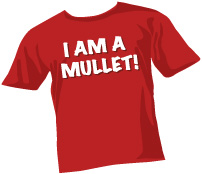
The grip width is an individual matter. Although generally the closer your hands, the more stable the load, most bodybuilders are too big and tight to grip the bar inside the power rings. Most heavyweight powerlifters have to grab it near the plates and it is not by choice.
You will be able to bring your hands closer – while minimizing or eliminating wrist and thumb discomfort – by taking a thumbless grip. Naturally, you will have to squeeze the bar tight throughout your set.
To end the shoulder joint discomfort, you will have to drive your elbows forward as far as possible, as you are unracking the weight – and keep them there. Do not lift your shoulders in the process! It is not easy but if the iron game was easy everyone would be playing it.
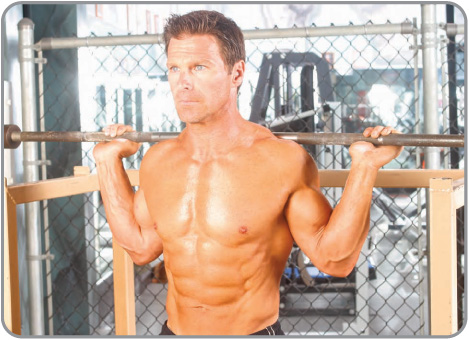
How to hold the bar.
The combination of the depressed and adducted scapulae, a tight false grip, and the forward elbow pressure will lock the bar tightly in place while unloading your beaten up joints. Some gym rats with good shoulders may also try drawing the elbows together, as in a chest fly, in addition to pushing them forward; this maneuver will immobilize your joints in one more plane.
Embarking on an intelligent shoulder flexibility program will help your squats big time. One effective exercise is the press behind the neck with an empty bar and a forward lean. Consider doing these before your squats. Start overhead with partial reps and gradually work them down.
Question: My knees tend to bow in when I squat heavy. How can I overcome this problem?
Some powerlifters recommend “spreading the floor” with your feet. A powerful technique, but don’t you dare use it unless you are convinced there is enough friction between your shoes and the platform. If you feet slip or your ankle rolls, you are a goner…
A safer alternative is to ‘screw’ your feet into the platform, from inside out. Your feet should not move but you should feel a spiral of tension running from your groin to your feet. Your knees are a lot less likely to bow in. Plus, you cannot help noticing that some new muscles kick in. The result: an even greater strength and development.
A unique approach to strengthening the hip abductors in the squat specific way was invented at the Westside Barbell Club. Loop a sturdy rubber band around your knees -the WSB guys use Jump Stretch bands – and squat with your bodyweight.
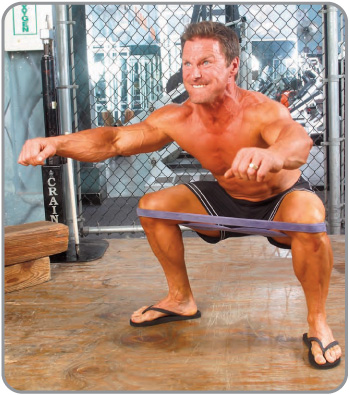
No more bowing knees!
Question: My knees have been aching lately from my leg routine. My doctor says there is nothing wrong with me and the strength coach who watched me lift and checked my routine said I was all squared off. Do you have any ideas?
Drs. Apel and Latan, who once took care of the East German national weightlifting team, recommend that you do not do exercises back to back, that require deep knee flexion. Insert exercises that are easier on the knees – such as deadlifts and exercises for other body parts – between different types of deep squats. This is the standard operating procedure for the victorious Russian national powerlifting team.
Here is another tip for you. Slowly squat down rock bottom without a weight. Place the tips of your right index finger and thumb just above your right kneecap. Now slowly move your digits apart from each other: your finger will slide up to the top of the patella while your thumb will go down towards your quad. Slide them about four inches apart while pressing lightly on your skin, and then start over from the center. While you are doing this visualize that the part of your thigh below your finger and thumb is ‘elongating’ along with the movement of the digits to ‘make more space for your knee’. Now try to recreate this ‘open’ sensation ‘hands off’ as you are slowly descending into the squat. Imagine that your kneecap is ‘separating from your knee.’ This voodoo sounding technique will noticeably unload your knees. It never fails in the RKC kettlebell instructor course.
Question: I have been following your writings for a while and have seen you stress the importance of planting your heels flat and not letting your knees stick out forward in the squat many times. Now I see you recommend Hack squats in your interview with Outside magazine. What about those shearing forces? Have you switched parties?
Is it my conversion from a Commie to a running capitalist dog that gave you this idea? There is no inconsistency, Comrade. A properly performed Hack squat – the spine upright and the hands against the tailbone rather than under the thighs – imposes a brutal leverage. To give you an idea, you need to barbell squat at least 300 to stand a chance of hacking a 70-pound kettlebell. Senior RKC Steve Maxwell hacks an 88-pounder for reps. For kicks he challenged a couple of 600-pound squatters to try it. They could not stand up.
Pushing those knees forward with 70 and with 300 pounds are two very different ball games. Because the weight is light and the reps are low healthy knees should have no problem with Hack squats.
A couple of tips for powerful Hack squats. First, drive hard with your glutes, pinch an imaginary coin with your cheeks; it is the only way to remain upright. Contrary to the popular belief, Hacks do not isolate the quads. Second, flare your knees out, especially if you have long thighs. And third, you will master the movement quicker if you start from the top as in the regular squat rather than from the deck. Tense your glutes, open your chest and descend, insisting on keep your spine vertical. Looking way up will help. You should get the sense for the required balance and will have an easier time getting up. There is no dishonor in practicing without any weight first.
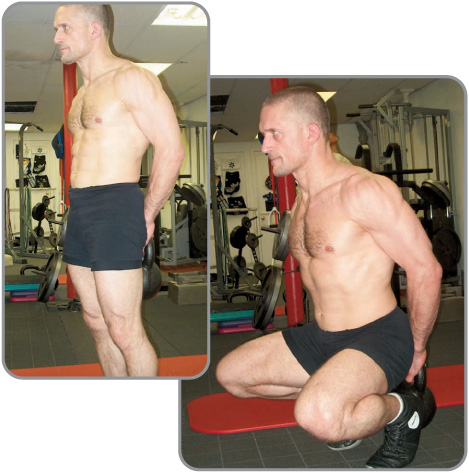
Can you Hack it like Steve Maxwell? Photos courtesy SteveMaxwell.com